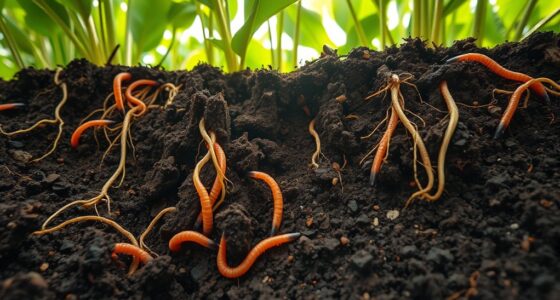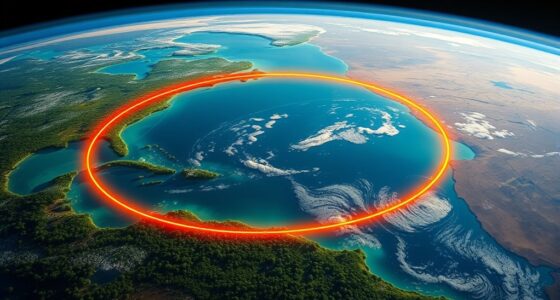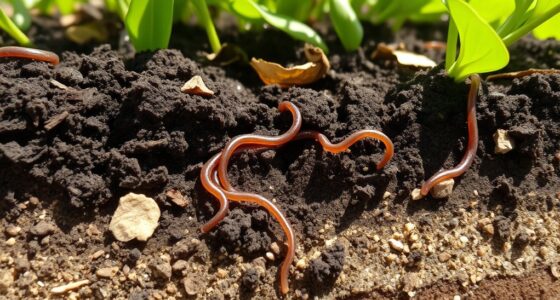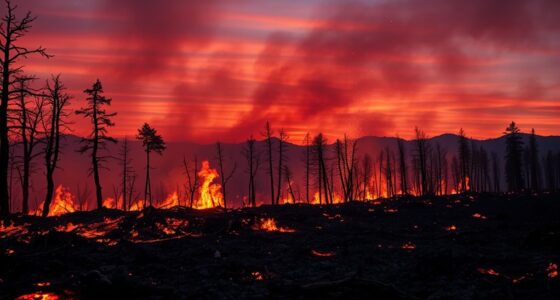Keystone species are crucial for keeping ecosystems healthy by regulating other populations and creating habitats. When these species decline or disappear, ecosystems can become unstable, leading to overgrowth or collapse of food webs. Their actions support biodiversity and resilience, helping habitats stay stable and productive. Protecting keystone species is essential for maintaining ecosystem balance. If you want to understand how they influence environment stability and why they matter, there’s more to discover ahead.
Key Takeaways
- Keystone species maintain ecosystem stability by regulating species populations and habitat conditions.
- Their removal can cause cascading effects, leading to decreased biodiversity and ecosystem collapse.
- They act as ecosystem engineers, modifying habitats to support diverse species.
- Protecting keystone species enhances ecosystem resilience against environmental stresses.
- Recognizing their role emphasizes the importance of conservation efforts for overall ecosystem health.

Have you ever wondered what keeps an ecosystem balanced and thriving? The answer lies in the complex relationships between different species and their environment. When a keystone species is present, it plays a indispensable role in maintaining these connections, ensuring the ecosystem functions properly. Without it, the delicate balance can quickly unravel, leading to issues like biodiversity loss and compromised habitat stability. Your understanding of keystone species reveals how essential they are in supporting the health of entire ecosystems.
Biodiversity loss is a significant threat to ecosystem stability and resilience. When keystone species disappear or decline, the ripple effects can be devastating. For example, if a top predator is removed, prey populations may explode, which can overconsume vegetation or other resources. This imbalance can cause the collapse of specific food webs and reduce overall biodiversity. As species vanish, ecosystems become less resilient to environmental stresses, such as climate change or diseases. In turn, the habitat stability that once supported a diverse array of life becomes fragile, making recovery more difficult once disruptions occur.
You might think that each species is just a small part of a larger puzzle, but keystone species are the crucial pieces that hold the whole picture together. They influence the abundance and diversity of other organisms, often through predation, habitat modification, or resource provisioning. For instance, beavers act as ecosystem engineers by building dams that create wetlands, which support numerous plants and animals. Their activity stabilizes habitats and promotes biodiversity. When such key players are absent, the entire ecosystem can shift dramatically, often toward less diverse and less stable states.
Maintaining habitat stability depends heavily on the presence of keystone species. They help control populations, foster diverse habitats, and prevent overexploitation of resources. Their actions create a balance that allows other species to thrive, which in turn supports ecosystem productivity and resilience. Without these influential species, ecosystems become more susceptible to invasive species, environmental stressors, and sudden shifts, all of which diminish biodiversity and habitat stability. Recognizing the importance of keystone species emphasizes the need for conservation efforts aimed at protecting those crucial individuals that uphold ecosystem health. Additionally, understanding the role of mindfulness and connection can enhance our efforts in conservation by fostering a deeper appreciation for these vital species.
Frequently Asked Questions
How Do Keystone Species Affect Biodiversity?
You can see that keystone species critically impact biodiversity by triggering trophic cascades that maintain ecological balance. When these species thrive or decline, they influence various levels of the food web, affecting numerous organisms. By controlling prey populations or shaping habitat, keystone species help preserve diverse ecosystems. Without them, ecosystems risk collapsing or becoming less resilient, underscoring their essential role in sustaining biodiversity.
Can Keystone Species Be Reintroduced After Extinction?
Yes, keystone species can be reintroduced after extinction, though it depends on reintroduction feasibility. For example, in Yellowstone, wolves were reintroduced, restoring ecological balance. If a keystone species goes extinct, recovery efforts focus on extinction recovery and reintroduction strategies. While challenging, successful reintroductions can revive ecosystem functions. Your role involves supporting conservation initiatives that evaluate these efforts and promote biodiversity resilience.
What Are Examples of Keystone Species Globally?
You’ll find examples of keystone species worldwide, such as marine predators like sea otters that control sea urchin populations, and habitat engineers like beavers that create wetlands. These species play vital roles in maintaining ecosystem balance. Their presence influences the diversity and health of habitats, demonstrating how specific species profoundly shape their environments. Protecting and understanding these keystone species helps preserve the overall health of ecosystems globally.
How Do Keystone Species Influence Human Activities?
Imagine a delicate web where one tug can unravel everything. You influence human activities by recognizing how keystone species maintain ecosystem balance through trophic cascades. Protecting these species guarantees healthy environments, supports agriculture, and sustains fisheries. When keystone species decline, ecosystems falter, impacting your resources and livelihoods. Your actions, like conservation efforts, help preserve this balance, preventing disruptive cascades and ensuring ecosystems continue to thrive for future generations.
What Threats Do Keystone Species Face Today?
Today, keystone species face threats like habitat destruction and invasive species. Habitat loss from human development reduces their living areas, while invasive species compete with or prey on them, disrupting ecosystem balance. These threats weaken keystone species’ populations, risking broader ecological impacts. You can help by supporting conservation efforts, reducing habitat destruction, and controlling invasive species, ensuring these crucial organisms continue to maintain healthy, resilient ecosystems.
Conclusion
Understanding keystone species is like discovering the keystones in an arch—you realize how crucial they are to holding everything together. When these species thrive, your ecosystem stays balanced and healthy, like a finely tuned orchestra. Without them, the whole system risks collapsing like a house of cards. So, by protecting keystone species, you’re safeguarding the intricate web of life that supports your environment, ensuring it remains vibrant and resilient for generations to come.










